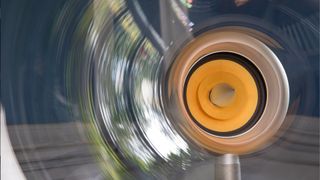This transparent horn speaker system is clearly outrageous – and I have to have it
How many times have you walked into your hi-fi listening room (which can double as your TV room, your laundry/drying room or even your bedroom) and thought, ‘man, I wish I didn’t have to walk around all the time’ my speakers to see what’s behind them – in fact, I wish I just had speakers that looked like interdimensional time portals’?
British maker Ferguson Hill has been working on these incredible beasts for a while now – since the release of the company’s groundbreaking FH001 twenty years ago, to be precise. The Jetstream speaker system is, says the Kent specialist, the best design ever.
As far as I’m concerned, this is preaching to the converted – this is what I already want. How to describe the aesthetic? The larger horn speakers are not much different in size and shape from the Avantegrade Trio G3 speaker system I saw in High End Munich (scroll to point five), but the striking transparency makes them look otherworldly, like floating spheres or even moon jellyfish.
The complete Jetstream speaker system consists of a pair of Jetstream horn speakers, a pair of Jetstream bass speakers and a Jetstream bass amplifier. These beautiful horn speakers feature the company’s own semi-full-range drive unit, made in collaboration with Cube Audio of Poland, and while much of the new system is transparent, many of the improvements to the structure are internal – the damping structures between the metal ring and the drive unit and the internal leg damping for example.
So come on, how much? Well, the complete Ferguson Hill Jetstream system costs £105,200, which works out to around $133,385 or AU$202,530, excluding shipping and associated import duties – and note that each of the horn speakers weighs 32kg, so that won’t be cheap. You can also buy the Ferguson Hill Jetstream Horn speaker pair on its own for £72,955.00 (about $92,550 or AU$140,510 before extras), but I think just the full set including amplification would be sufficient.
Advice: Why You Should Consider Horn Speakers
I’ve said it before and I’ll say it again: You might think that modern speakers should be driver-filled towers – two- or three-way wooden boxes containing a crossover to send each frequency to the appropriate drive unit – but Now having heard what this kind of design can actually do (see Western Electric’s 1927 12B speaker, which I heard blasting out Led Zep last year), I disagree.
The WE 12B snail horn used in the above product, at High End Munich, was a milestone in audio history and although it was made from 180 pieces of hardwood and Ferguson Hill’s 2024 proposal is made from transparent acrylic, it design makes sense for an audiophile – here the horn rolls off naturally below about 140 Hz due to backwave cancellation, with the size of the horn representing a quarter of the wavelength spacing at 140 Hz.
Aside from not being stuck above or below other drivers in a box that needs damping and bracing to deal with resonance and interference, horns are great for sonic reproduction because they require much less power to give you loud music. – also known as more efficient. Simply put, nature likes curves and waves, she doesn’t like straight lines.
Look, it would hardly be fair to compare this speaker to some of the best stereo speakers we’ve had the pleasure of testing – unfortunately, most of us have a limited budget for speakers and most of the products in our buying guide take this into account.
What would be interesting is to hear them against the Sonus Faber Suprema 2.2 system, one of the best audio products unveiled at CES 2024 and yours for a cool $750,000 / £695,000 (about AU$1.3 million ). Well, that would be nice…

